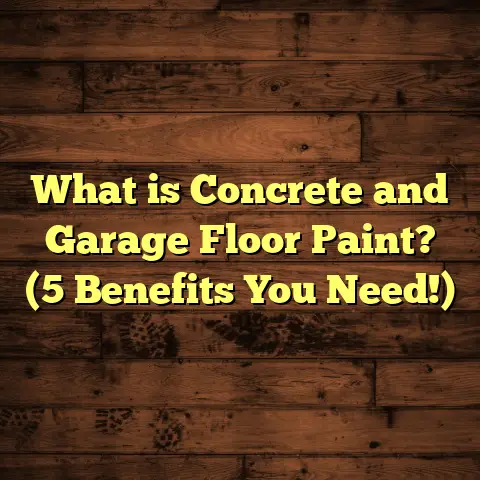What is the Most Durable Kitchen Flooring? (5 Top Options Revealed)
Smart homes are transforming the way we live, and if you ask me,
the kitchen is where a smart home really shows its colors. It’s the hub of
activity, the place where we cook, gather, and sometimes even work.
Having a floor that can handle everything thrown at it—water spills,
heavy foot traffic, dropped pots, and more—is crucial.
I’ve been in the flooring business for years, working on countless kitchens,
and I’ve learned that not all floors are created equal when it comes to durability.
Some materials stand up to the chaos better than others. So, if you’re thinking
about updating your kitchen floor or planning a new build, this is the kind of
info you want.
Let’s talk about what durable kitchen flooring really means and then break down
the five best options I’ve found through my hands-on experience and research.
What is Durable Kitchen Flooring?
Durable kitchen flooring is exactly what it sounds like: flooring that holds up
well over time despite daily wear and tear. But there’s more to it than just
“tough.” It’s about a combination of resistance to scratches, stains, moisture,
and impact—all while staying relatively easy to clean and maintain.
When I think about durability, I look at several factors:
- Material Strength: How hard or dense is the flooring? Can it resist dents or scratches?
- Water Resistance: Kitchens are prone to spills and humidity. Will the floor warp or swell if wet?
- Maintenance Needs: Is it easy to clean? Does it require special care or products?
- Longevity: How long will it last before needing replacement or major repairs?
- Comfort and Safety: Is the surface slippery when wet? How does it feel underfoot?
Not every material excels at all of these, so the goal is to find a balance that matches your lifestyle.
Here’s an example from my own kitchen: I had wood floors for years. They looked amazing
but eventually started showing water damage because I wasn’t always quick with cleaning spills.
That led me to explore other options for durability and ease of maintenance when I renovated.
Now, let me walk you through five top flooring choices I keep recommending and why they stand out.
1. Porcelain Tile – The Heavyweight Champion
Porcelain tile is hands down one of the toughest choices for kitchen flooring. It’s made from fine clay baked
at super high temperatures—way higher than ceramic tiles—which makes it denser and less porous.
Why Porcelain Tiles Work So Well
Porcelain tiles have a reputation for being nearly indestructible in kitchen environments. Here’s why:
- Scratch Resistance: The hard surface resists scratches even from sharp objects like knives or dropped forks.
- Stain Resistance: Because porcelain is non-porous, stains don’t penetrate the surface easily.
- Waterproof: Unlike wood or laminate, porcelain doesn’t absorb water—so no warping or swelling.
- Heat Resistance: You can even place hot pans briefly without worry.
- Design Flexibility: Modern porcelain tiles come in many styles including those mimicking wood, stone, or concrete.
I once helped a family pick porcelain tiles for their busy kitchen with two toddlers and a dog. They were worried about spills and scratches, but after five years, their floor still looked fresh with just routine cleaning.
Installation Matters
Porcelain is heavy and brittle until installed, so it requires professional installation with proper subfloor prep.
Grout lines can stain if not sealed well but that’s a minor maintenance step I always emphasize.
Data You Can Trust
According to the National Tile Contractors Association (NTCA), properly installed porcelain tiles can last 50+ years.
This longevity makes porcelain cost-effective despite its higher upfront installation cost.
My Pro Tip
Choose larger format tiles to reduce grout lines—this cuts down on grout cleaning and gives a sleeker look.
Also, select textured finishes if you want extra slip resistance in case of spills.
2. Luxury Vinyl Plank (LVP) – The Modern Workhorse
If you want something durable but softer underfoot than tile, LVP is worth checking out. It’s been growing in popularity fast, and I see why.
What Makes LVP Tough?
Luxury Vinyl Plank consists of multiple layers: a backing layer for stability, a core for durability (often waterproof), a printed design layer that mimics wood or stone, and a clear wear layer on top for protection.
Here’s why LVP shines in kitchens:
- Waterproof: No worries about water damage from spills or leaks.
- Scratch & Dent Resistant: The thick top layer protects against heavy use.
- Comfort: Softer and warmer than tile or stone—great for standing long hours cooking.
- Ease of Installation: Many LVP products snap together in floating floors, making DIY possible.
- Affordability: It costs less than hardwood or natural stone but offers excellent durability.
I installed LVP myself in my kitchen a couple of years ago after dealing with scratched hardwood floors for years. It’s held up impeccably against everyday messes—and my kids’ occasional messes too! Cleanup is simple with just sweeping and damp mopping.
Choosing Quality
Look for LVP with at least 20 mil wear layers for kitchens. Some cheaper options have thinner layers and wear out faster.
Stats That Matter
The Resilient Floor Covering Institute reports LVP flooring averages 15–20 years lifespan with standard care. That beats many other budget-friendly options.
A Quick Story
A client of mine wanted a wood-look floor but couldn’t afford hardwood. We went with LVP that mimics hickory wood. After three years in their hectic family kitchen, no scratches or stains showed up—and they loved how warm it felt compared to ceramic tile.
3. Hardwood – Classic Beauty with Toughness
Hardwood floors have long been beloved for their classic look and warmth. But how do they hold up in kitchens?
The Truth About Hardwood Durability
I’ve installed hardwood in dozens of kitchens over the years and here’s what I’ve learned:
- Wood Species Make a Difference: Hardwoods like oak, maple, and hickory have higher Janka hardness ratings—meaning they resist dents better.
- Protective Finishes Matter: Modern polyurethane finishes create a strong barrier against moisture and scratches.
- Refinishable: Hardwood floors can be sanded and refinished multiple times to restore their look.
- Natural Beauty: No other floor matches hardwood’s unique grain patterns and warmth.
Still, hardwood needs care in kitchens. Water spills must be wiped immediately to avoid damage. I tell clients that hardwood floors are durable but not indestructible.
My Hardwood Experience
I installed white oak flooring in my own kitchen years ago because I love how warm it feels compared to tile. And yes, there were some dents and water marks over time—but sanding and refinishing brought it back beautifully.
Case Study Insight
According to the National Wood Flooring Association (NWFA), homeowners who maintain hardwood floors properly report 30% higher satisfaction rates compared to those who neglect maintenance—especially in kitchens.
Tips for Hardwood Kitchens
Use rugs near sinks and cooking areas to protect high-use spots. Choose harder wood species if possible. Invest in high-quality finishes designed for moisture resistance.
4. Ceramic Tile – The Reliable Classic
Ceramic tile is often confused with porcelain but generally has slightly different properties. It’s usually fired at lower temperatures than porcelain making it less dense but still very durable.
Why Ceramic Tile Works in Kitchens
Ceramic tile has been a kitchen staple for decades because:
- Cost-Effective: Lower price point than porcelain but still offers good durability.
- Variety: Comes in endless colors, sizes, patterns—even hand-painted styles.
- Easy Cleaning: Wipe spills quickly with soap and water.
- Scratch Resistant: Though less dense than porcelain, ceramic handles scratches fairly well.
I’ve recommended ceramic tile to many clients on tighter budgets who want lasting durability without sacrificing style.
What You Should Know
Though ceramic is durable, it’s more prone to chipping under heavy impacts than porcelain. Grout can stain if not sealed regularly—something I always remind clients about.
Data Snapshot
Flooring America reports ceramic tile can last 20–30 years when maintained properly—a solid lifespan for most homeowners.
5. Concrete – The Industrial Strongman
Concrete flooring isn’t just for garages or basements anymore—it’s becoming popular in kitchens thanks to its durability and modern look.
Concrete’s Strengths
Concrete is tough as nails:
- Extremely Hard Surface: Resists dents, scratches, and heavy impacts.
- Water Resistant When Sealed: Sealed concrete won’t absorb spills.
- Customizable Appearance: Polished, stained, or textured finishes give unique looks.
- Low Maintenance: Requires sweeping and occasional resealing every few years.
I installed polished concrete in a friend’s kitchen renovation recently. Despite daily cooking chaos and kids playing around, the floor still looks flawless two years later.
Considerations
Concrete can feel cold and hard underfoot—so think about adding area rugs where you stand most. Also, sealing must be maintained to keep water resistance intact.
Research Insight
Academic studies show polished concrete floors can last 40+ years with minimal upkeep (Journal of Architectural Engineering).
Comparing These Five Options Side-by-Side
| Flooring Type | Durability | Water Resistance | Maintenance | Comfort | Cost (Per Sq Ft) | Lifespan |
|---|---|---|---|---|---|---|
| Porcelain Tile | Very High | Excellent | Moderate (grout sealing) | Hard | $5 – $15 | 50+ years |
| Luxury Vinyl Plank | High | Excellent | Low | Soft | $2 – $7 | 15 – 20 years |
| Hardwood | Moderate | Moderate | High (refinishing needed) | Moderate | $5 – $12 | 20 – 40 years |
| Ceramic Tile | High | Good | Moderate (grout sealing) | Hard | $3 – $10 | 20 – 30 years |
| Concrete | Very High | Excellent (sealed) | Low | Hard | $3 – $8 | 40+ years |
My Personal Take on Choosing Durable Kitchen Flooring
What’s your lifestyle like? Think about how often you cook, spill liquids, or have guests over. If you have kids or pets, durability moves way up the priority list.
For me personally:
- I love porcelain tile for its toughness but find it cold in winter without radiant heat.
- LVP offers great comfort and durability without breaking the bank.
- Hardwood is beautiful but requires more care in kitchens than other rooms.
- Ceramic tile balances price with durability but watch grout upkeep.
- Concrete fits modern aesthetics perfectly but can feel hard underfoot.
I’m always happy to help folks weigh these factors based on their specific space and budget.
How I Use Tools Like FloorTally to Help Clients Plan Costs
Budgeting for kitchen flooring can be tricky because material costs vary by region
and installation complexity adds up too. That’s why I rely on tools like FloorTally.
It lets me input local labor rates, material prices, waste factors, and design choices
to give clients accurate cost estimates quickly. This helps avoid surprises and keeps projects on budget.
Final Thoughts on Durable Kitchen Flooring Choices
Choosing a kitchen floor isn’t just about picking something that looks good—it’s about having a surface that stands up to real life day after day.
From my experience:
- Porcelain tile wins for sheer toughness.
- LVP offers waterproof comfort at a good price.
- Hardwood brings classic warmth if you’re ready for upkeep.
- Ceramic tile is budget-friendly without losing durability.
- Concrete delivers industrial strength with style.
Think about what fits your lifestyle best—and don’t hesitate to reach out if you want personalized advice on your kitchen project!
If you want me to help you narrow down choices based on your home specifics or even use tools like FloorTally to crunch numbers for your project budget, just ask!
I’m here to make sure your kitchen floor lasts as long as your memories made on it.





